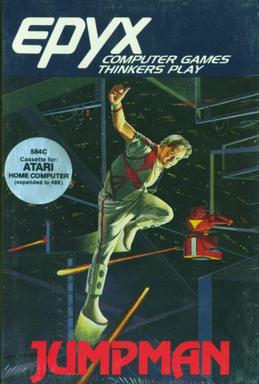
Jumpman is a platform game written by Randy Glover and published by Epyx in 1983. It was developed for the Atari 8-bit computers, and versions were also released for the Commodore 64, Apple II, and IBM PC compatibles.
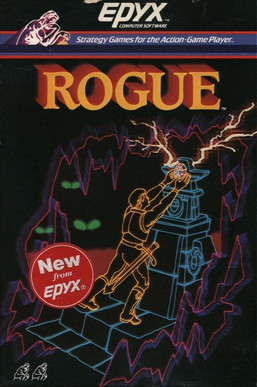
Rogue is a dungeon crawling video game by Michael Toy and Glenn Wichman with later contributions by Ken Arnold. Rogue was originally developed around 1980 for Unix-based minicomputer systems as a freely distributed executable. It was later included in the Berkeley Software Distribution 4.2 operating system (4.2BSD). Commercial ports of the game for a range of personal computers were made by Toy, Wichman, and Jon Lane under the company A.I. Design and financially supported by the Epyx software publishers. Additional ports to modern systems have been made since by other parties using the game's now-open source code.

Epyx, Inc. was a video game developer and video game publisher active in the late 1970s and 1980s. The company was founded as Automated Simulations by Jim Connelley and Jon Freeman, originally using Epyx as a brand name for action-oriented games before renaming the company to match in 1983. Epyx published a long series of games through the 1980s. The company's assets are currently owned by Bridgestone Multimedia Group Global.

Temple of Apshai is a dungeon crawl role-playing video game developed and published by Automated Simulations in 1979. Originating on the TRS-80 and Commodore PET, it was followed by several updated versions for other computers between 1980 and 1986.
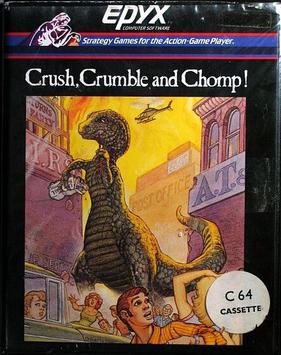
Crush, Crumble and Chomp! is a video game where the player takes control of a movie monster and attacks a major city, such as New York or San Francisco. It was published in 1981 for the TRS-80, Apple II, and Atari 8-bit computers. Ports to the VIC-20, Commodore 64, and IBM PC compatibles were released later. Some versions were published under the company's original name of Automated Simulations, while the rest use Epyx.

Rescue at Rigel is a science fiction role-playing video game developed by Automated Simulations and published in 1980. It is based on a modified version of their Temple of Apshai game engine, which was used for most of their releases in this era. The game was released for the Apple II, IBM PC, TRS-80, Commodore PET, VIC-20, and Atari 8-bit computers.

A video game with nonlinear gameplay presents players with challenges that can be completed in a number of different sequences. Each player may take on only some of the challenges possible, and the same challenges may be played in a different order. Conversely, a video game with linear gameplay will confront a player with a fixed sequence of challenges: every player faces every challenge and has to overcome them in the same order.
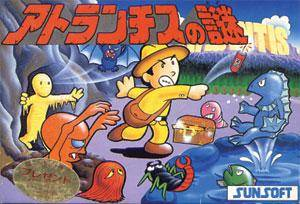
Atlantis no Nazo is a side-scrolling platform game developed and published by Sunsoft and released for the Family Computer in 1986.

Gateway to Apshai is an action-adventure game for the Commodore 64, ColecoVision and Atari 8-bit computers. It was developed by The Connelley Group and published by Epyx in 1983 as a prequel to Temple of Apshai. It is a more action-oriented version of Temple of Apshai, with smoother and faster graphics, streamlined controls, fewer role-playing video game elements, and fewer room descriptions.

SwordThrust is an interactive text adventure game for the Apple II, created by Donald Brown and published by CE Software in 1981. It consists of seven separate adventures and is the commercial successor to Brown's Eamon (1980).

Telengard is a 1982 role-playing dungeon crawler video game developed by Daniel Lawrence and published by Avalon Hill. The player explores a dungeon, fights monsters with magic, and avoids traps in real-time without any set mission other than surviving. Lawrence first wrote the game as DND, a 1976 version of Dungeons & Dragons for the DECsystem-10 mainframe computer. He continued to develop DND at Purdue University as a hobby, rewrote the game for the PET 2001 after 1978, and ported it to Apple II+, TRS-80, and Atari 8-bit computers before Avalon Hill found the game at a convention and licensed it for distribution. Its Commodore 64 release was the most popular. Reviewers noted Telengard's similarity to Dungeons and Dragons. RPG historian Shannon Appelcline noted the game as one of the first professionally produced computer role-playing games, and Gamasutra's Barton considered Telengard consequential in what he deemed "The Silver Age" of computer role-playing games preceding the golden age of the late 1980s. Some of the game's dungeon features, such as altars, fountains, teleportation cubes, and thrones, were adopted by later games such as Tunnels of Doom (1982).
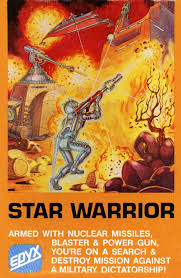
Star Warrior is a 1980 science fiction role-playing video game written and published by Automated Simulations for the Apple II, TRS-80, and Atari 8-bit computers. The game is branded as part of the Starquest series, consisting of Star Warrior and the otherwise unrelated Rescue at Rigel.

The Legend of Blacksilver is a fantasy role-playing video game developed by Charles W. Dougherty and John C. Dougherty of Quest, Inc. and published by Epyx in 1988. It is an indirect sequel to the game Legacy of the Ancients. Originally designed for the Commodore 64, the game was ported to the Apple II.

Temple of Apshai Trilogy is a remake of three games from the Dunjonquest series, Temple of Apshai, Upper Reaches of Apshai, and Curse of Ra.
Dunjonquest is a series of single-player, single-character fantasy computer role-playing games by Automated Simulations. Temple of Apshai was the most successful and most widely ported game in the series. The games relied on strategy and pen & paper RPG style rules and statistics.

Dragonriders of Pern is a video game published by Epyx in 1983 based on Anne McCaffrey's book series of the same name. The game was released for the Atari 8-bit computers and Commodore 64.
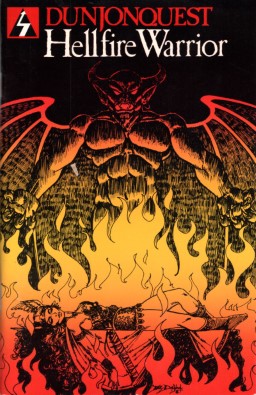
Hellfire Warrior is a dungeon crawl video game for the Apple II, Commodore PET, and TRS-80 published by Automated Simulations in 1980. A port to Atari 8-bit computers was released in 1982. Hellfire Warrior is the direct sequel to 1979's Temple of Apshai. Two expansion packs were published.

Sorcerer of Siva is a 1981 video game published by Automated Simulations for the Apple II and TRS-80. The last standalone Dunjonquest game, Sorcerer of Siva is not as large as the major releases in the series, but also not as small as the MicroQuests.

The Battle of Shiloh is a 1981 computer wargame published by Strategic Simulations. It is one of the first Civil War strategy computer games, and was the first Strategic Simulations game available on the TRS-80. Intended as an introductory war game, it was available on the Commodore 64, Apple II, and Atari 8-bit computers, TRS-80, and IBM PC, and was originally developed by David Landry and Chuck Kroegel through their studio "Tactical Design Group".


















